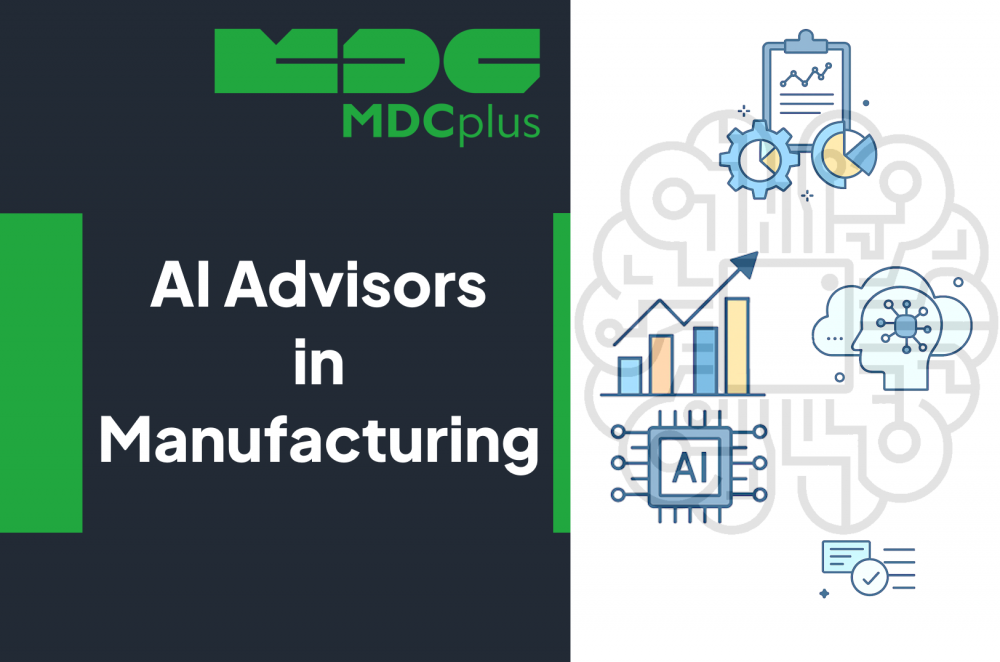AI Advisors in Manufacturing: The Rise of Data-Driven Decision Intelligence
Data has become one of the most valuable assets on the shop floor. But while sensors, machines, and software collect massive amounts of information every second, the real challenge lies in making sense of that data - quickly and accurately.
Enter the era of AI advisors: intelligent software agents designed to analyze complex datasets and guide strategic and operational decisions. These virtual co-pilots are transforming how manufacturers plan, produce, and perform - bringing new levels of precision, efficiency, and adaptability to modern industry.
1. Production Optimization Agent: Squeezing More from Every Cycle
Purpose: Enhance production efficiency and reduce downtime.
This AI advisor continuously monitors machine performance to identify inefficiencies. It doesn’t just flag problems - it offers solutions.
- Analyzes real-time and historical machine data
- Recommends optimal machine settings based on current operating conditions
- Suggests tool paths and feed rates tailored for specific materials and production goals
- Advises on shift strategies to maintain continuous flow
Use case: A CNC machine’s feed rate is dynamically adjusted based on material behavior and tool wear, improving throughput without compromising quality.
2. Predictive Maintenance Agent: Replacing Guesswork with Foresight
Purpose: Prevent unexpected breakdowns and extend equipment life.
This agent replaces reactive maintenance schedules with predictive precision.
- Uses sensor data like vibration, temperature, and load to detect anomalies
- Forecasts wear-and-tear patterns using machine learning
- Calculates ideal maintenance windows with minimal production disruption
Use case: Before a spindle motor fails, the agent alerts the maintenance team based on subtle changes in vibration data - avoiding unplanned downtime and saving thousands.
3. Demand Forecasting Agent: Aligning Production with Market Signals
Purpose: Match output to customer and market demand.
This AI assistant bridges the gap between the factory floor and the front office.
- Analyzes sales data, order history, and macroeconomic indicators
- Identifies seasonal trends and market shifts
- Provides dynamic production recommendations to avoid under- or overproduction
Use case: Ahead of a seasonal surge, the system increases forecast accuracy by analyzing regional demand and social trends - ensuring the plant is ready without excessive inventory buildup.
4. Quality Control Agent: Automating Product Consistency
Purpose: Maintain quality standards while reducing inspection overhead.
Rather than waiting for quality problems to surface, this agent detects them as they happen.
- Monitors real-time production metrics such as dimensions, tolerances, and material temperatures
- Detects drift or anomalies that lead to defects
- Recommends corrective actions, such as adjusting temperature, pressure, or cycle time
Use case: In a plastic molding operation, defect rates rise unexpectedly. The AI recommends a 5-degree temperature drop based on historical correlations - restoring part quality in real time.
5. Supply Chain Optimization Agent: Staying Ahead of Disruption
Purpose: Keep production running smoothly through smarter procurement and inventory management.
This agent monitors supply dynamics and forecasts material needs before shortages occur.
- Tracks supplier performance and delivery timelines
- Predicts material requirements based on production trends and forecasts
- Suggests stock adjustments to prevent both shortages and overstocking
Use case: Based on forecasted production increases and a supplier's delivery delays, the agent advises placing advance orders - avoiding costly production stoppages.
6. Energy Efficiency Agent: Cutting Costs Without Compromising Output
Purpose: Reduce energy waste and operational costs.
This AI-driven module focuses on sustainability as a core business driver.
- Analyzes energy consumption across machines, processes, and shifts
- Identifies inefficiencies and recommends adjustments
- Suggests load balancing, peak-shifting, and idle time reduction strategies
Use case: The agent identifies that two machines running during peak hours could be rescheduled to off-peak - cutting energy costs by 18% per month.
7. Workforce Management Agent: Optimizing People Power
Purpose: Align human resources with operational needs.
People remain central to manufacturing - and this agent ensures their talents are used effectively.
- Evaluates shift performance and labor productivity
- Suggests optimal staffing patterns based on production needs
- Identifies training needs and recommends upskilling paths
Use case: Noticing variability in quality across shifts, the agent proposes a redistribution of skilled operators - ensuring consistent output and reducing scrap.
Conclusion: From Data Collection to Decision Intelligence
AI-powered advisors are no longer experimental tools - they’re quickly becoming essential assets in competitive manufacturing environments. By transforming raw data into actionable insights, these agents allow leaders to make faster, smarter, and more strategic decisions.
Whether it’s improving yield, reducing costs, preventing failure, or empowering teams, AI is not replacing human judgment - it’s amplifying it.
As adoption grows, manufacturers will shift from simply being data-rich to being insight-rich, unlocking the full promise of Industry 4.0.
About MDCplus
Our key features are real-time machine monitoring for swift issue resolution, power consumption tracking to promote sustainability, computerized maintenance management to reduce downtime, and vibration diagnostics for predictive maintenance. MDCplus's solutions are tailored for diverse industries, including aerospace, automotive, precision machining, and heavy industry. By delivering actionable insights and fostering seamless integration, we empower manufacturers to boost Overall Equipment Effectiveness (OEE), reduce operational costs, and achieve sustainable growth along with future planning.
Ready to increase your OEE, get clearer vision of your shop floor, and predict sustainably?
